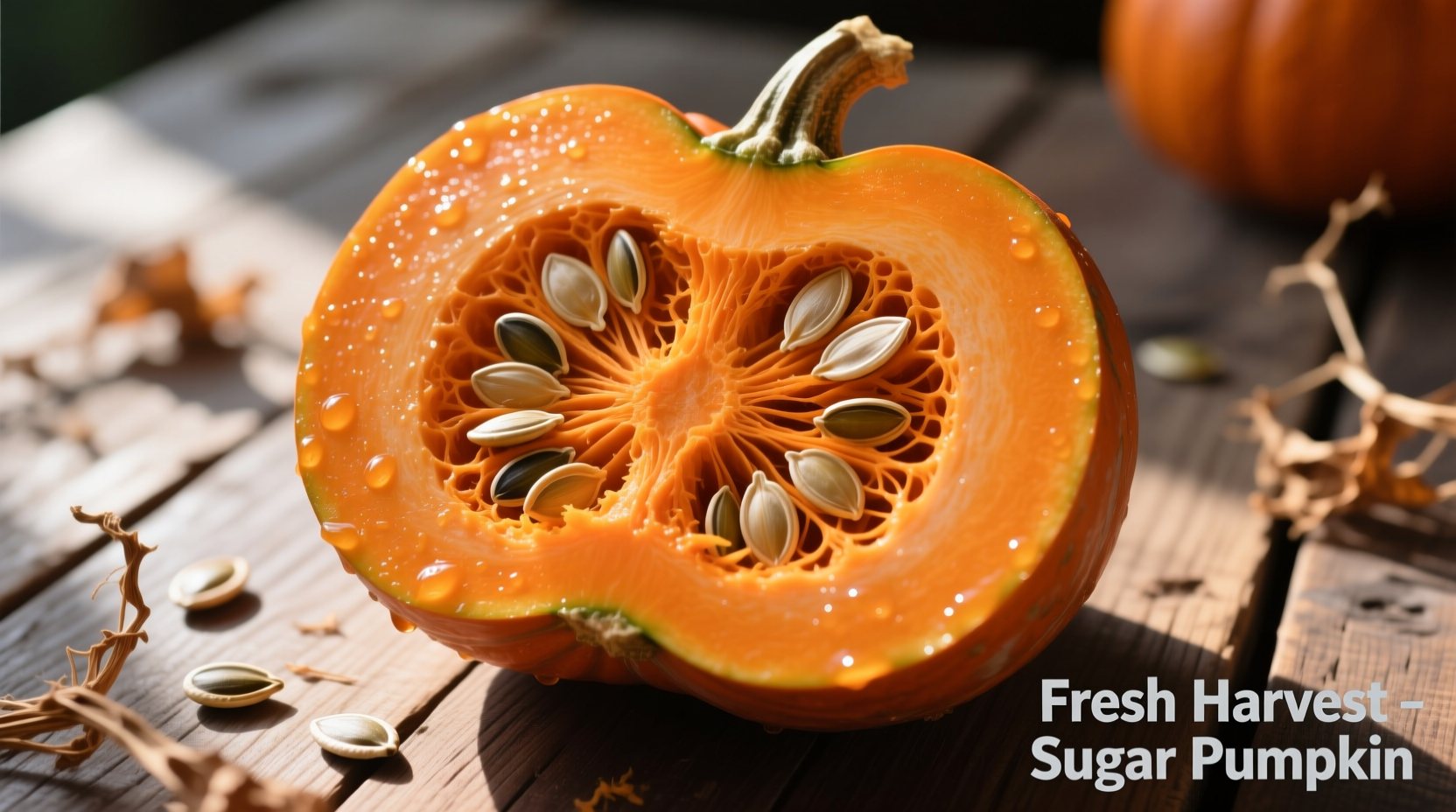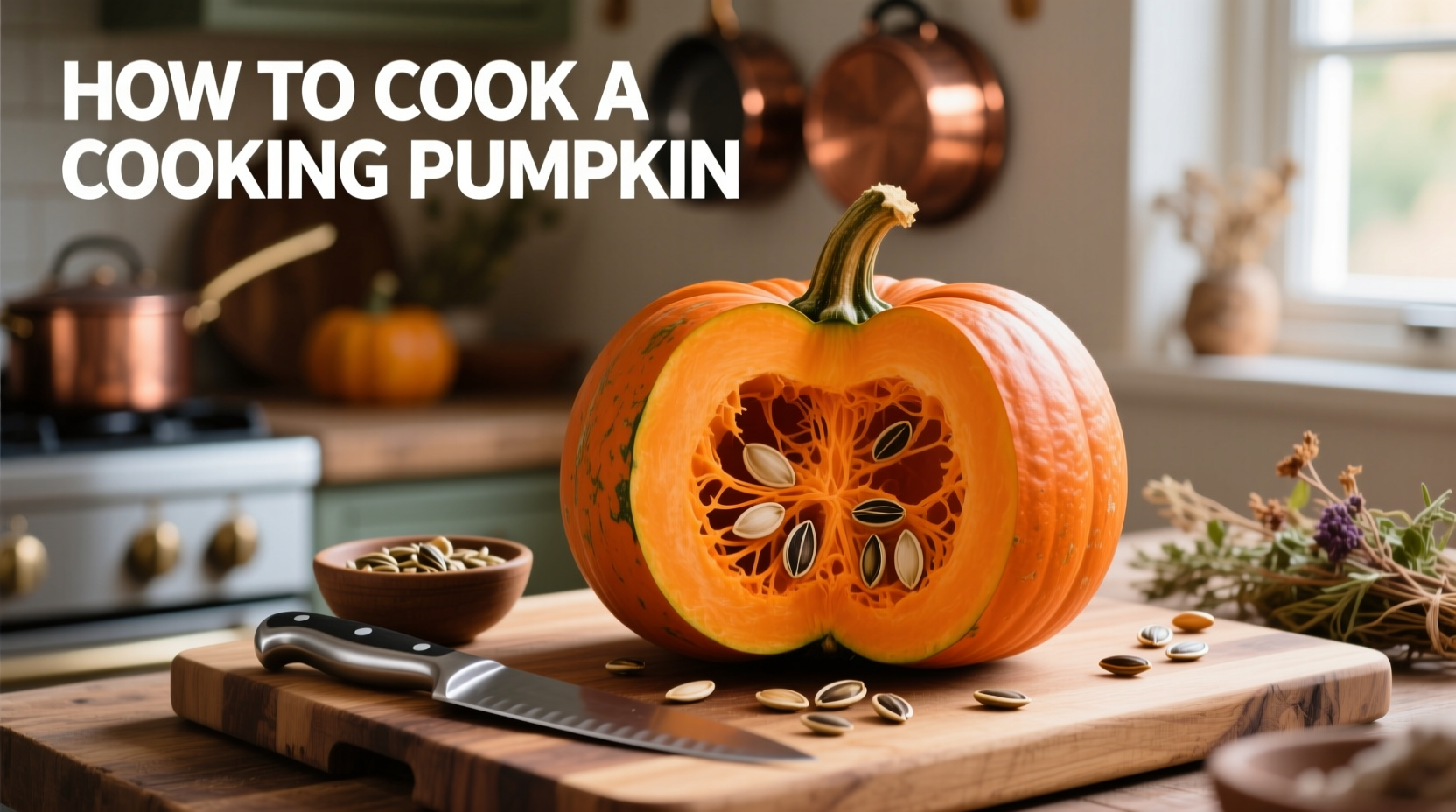Why Sugar Pumpkins Make All the Difference
Most people don't realize that the large orange pumpkins sitting on porches every October are terrible for cooking. Sugar pumpkins (also called pie pumpkins) contain nearly twice the sugar and half the water content of carving varieties. This fundamental difference transforms your dishes from watery disappointments to rich, flavorful creations.
| Characteristic | Cooking Pumpkin | Carving Pumpkin |
|---|---|---|
| Size | 4-8 inches diameter | 12+ inches diameter |
| Flesh Texture | Dense, smooth | Fibrous, stringy |
| Sugar Content | 8-10% Brix | 4-5% Brix |
| Water Content | 85-88% | 92-94% |
This factual comparison from Cornell University's Agricultural Extension explains why substituting carving pumpkins leads to watery pies and bland soups. The higher sugar concentration creates richer caramelization during roasting while the lower water content prevents soggy textures.
Selecting Your Perfect Cooking Pumpkin
Visit farmers' markets between September and November for peak quality. Look for these characteristics:
- Firm rind without soft spots or mold
- Deep orange color (avoid pale or greenish patches)
- Heavy for size indicating dense flesh
- Dry, woody stem (3-4 inches long)

Essential Preparation Steps
Before cooking, properly prepare your pumpkin:
- Wash thoroughly under running water to remove dirt
- Cut horizontally across the middle with a sharp chef's knife
- Scoop out seeds and stringy pulp using a sturdy spoon
- Peel using a vegetable peeler or carefully remove skin after cooking
- Cut flesh into 1-1.5 inch chunks for even cooking
According to USDA food safety guidelines, always wash pumpkins before cutting to prevent transferring surface bacteria to the flesh. Never use damaged or moldy pumpkins for cooking.
Four Foolproof Cooking Methods Compared
Each technique delivers different textures and flavors:
Roasting (Recommended Method)
This concentrates flavors through caramelization:
- Preheat oven to 375°F (190°C)
- Toss pumpkin chunks with 1 tbsp olive oil
- Spread in single layer on parchment-lined baking sheet
- Roast 45-55 minutes until fork-tender
- Cool slightly before handling
Professional chefs prefer roasting because the dry heat enhances natural sweetness. The Maillard reaction creates complex flavor compounds that boiling cannot replicate.
Boiling for Quick Puree
Ideal when you need pumpkin puree fast:
- Place chunks in large pot with 1 inch water
- Cover and bring to simmer
- Cook 15-20 minutes until tender
- Drain thoroughly in colander
- Press through fine mesh sieve
Important: Boiled pumpkin contains more moisture. For pie filling, simmer puree 5-7 minutes to evaporate excess water. This prevents soggy crusts - a common mistake home cooks make.
Steaming for Maximum Nutrient Retention
Preserves more vitamins than boiling:
- Add 2 inches water to pot with steamer basket
- Bring to rolling boil
- Place pumpkin chunks in basket
- Cover and steam 20-25 minutes
- Check tenderness with fork
Research from the USDA Food Data Central shows steamed pumpkin retains 25% more vitamin A than boiled versions. The gentle heat preserves delicate nutrients while softening the flesh.
Pressure Cooking for Speed
Perfect when time is limited:
- Add 1 cup water to pressure cooker
- Place chunks on trivet
- Seal and cook at high pressure 8 minutes
- Natural release 10 minutes
- Quick release remaining pressure
Pro Storage Techniques
Extend your cooked pumpkin's shelf life:
- Refrigerator: Store in airtight container for 5-7 days
- Freezer: Portion into 1-cup containers for 10-12 months
- Canning: Process in water bath 90 minutes (follow USDA guidelines)
Never leave cooked pumpkin at room temperature longer than 2 hours. The moist environment encourages bacterial growth, particularly Clostridium botulinum, which causes botulism. Always cool completely before refrigerating.
Transforming Cooked Pumpkin Into Delicious Dishes
Use your perfectly cooked pumpkin in these ways:
- Pie filling: Mix with eggs, cream, and spices
- Roasted cubes: Toss with maple syrup and pecans
- Soup base: Blend with broth and aromatics
- Pasta sauce: Puree with roasted garlic and sage
- Baking substitute: Replace oil in muffins at 1:1 ratio
Avoid These Common Cooking Mistakes
Even experienced cooks make these errors:
- Using carving pumpkins - results in watery, bland dishes
- Skipping the draining step - excess moisture ruins textures
- Overcooking - turns pumpkin to mush
- Adding sugar too early - causes burning during roasting
- Storing improperly - leads to spoilage and waste
Remember that cooking pumpkins naturally contain about 8-10% sugar - adding excessive sweeteners overwhelms their delicate flavor profile. Taste before adding sugar to determine actual need.
Seasonal Availability Timeline
Understanding pumpkin seasonality improves your results:
- August: Early varieties appear (Queensland Blue)
- September: Sugar pumpkins peak (ideal for cooking)
- October: Harvest continues with diverse heirloom types
- November: Storage varieties available (Kabocha, Buttercup)
- December-April: Winter squash substitutes (butternut, acorn)
This seasonal progression, documented by the USDA Agricultural Marketing Service, explains why November pumpkins often yield better cooking results than early September ones. The extra time in the field develops deeper flavor compounds through natural sugar conversion.
Frequently Asked Questions
Can I use regular pumpkins from my porch for cooking?
No, carving pumpkins contain significantly less sugar and more water than cooking varieties. Their flesh is fibrous and bland, resulting in watery dishes with poor texture. Always seek out sugar pumpkins or pie pumpkins specifically bred for culinary use.
How do I know when roasted pumpkin is done?
Perfectly roasted pumpkin should pierce easily with a fork but maintain its shape. The edges will show golden-brown caramelization. Undercooked pumpkin feels dense and resists the fork, while overcooked becomes mushy and separates. Total cooking time typically ranges from 45-55 minutes at 375°F for 1-inch chunks.
Why does my pumpkin puree taste watery?
Watery puree usually comes from using carving pumpkins or insufficient draining. Cooking pumpkins naturally contain less water, but boiled pumpkin needs thorough draining. For best results, spread puree on paper towels or in a fine mesh sieve for 15-20 minutes to remove excess moisture before using in recipes.
Can I freeze cooked pumpkin?
Yes, cooked pumpkin freezes exceptionally well. Cool completely, then portion into 1-cup containers or freezer bags. Remove as much air as possible and label with date. Properly stored, it maintains quality for 10-12 months. Thaw overnight in refrigerator before using.











 浙公网安备
33010002000092号
浙公网安备
33010002000092号 浙B2-20120091-4
浙B2-20120091-4